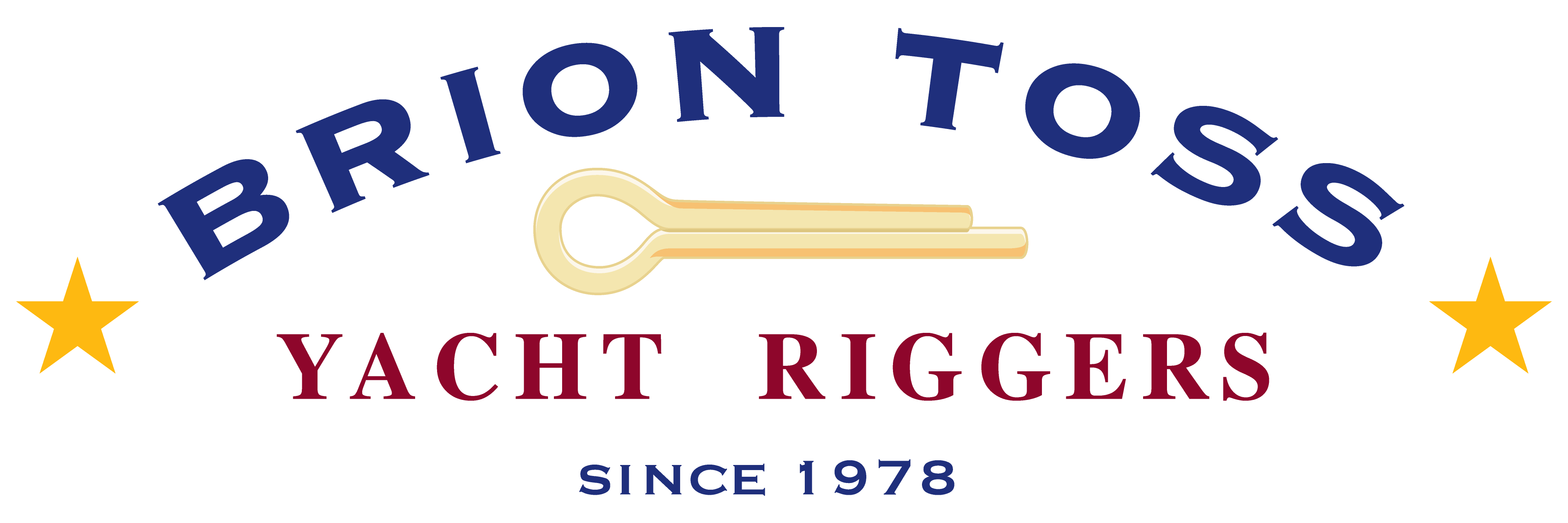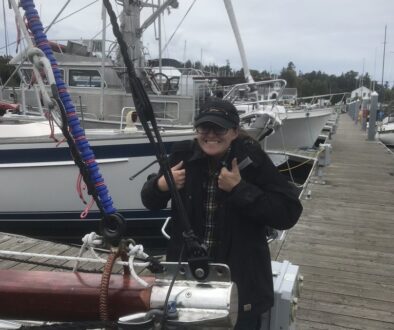The Client From Hell
Our clients tend to be wonderfully self-selecting; if they were the kind of jerks that we would rather not deal with, they probably wouldn’t be into cruising under sail to begin with. Year after year we see the truth of this, in the form of a succession of sailors who are perceptive, resourceful, generous, sensible, and infectiously enthusiastic, to name just a few of their virtues. Plus they pay their bills on time, and have even been known to complain that the bill wasn’t high enough.
If you think I’m exaggerating, bear in mind that it takes a rare kind of individual even to consider the cruising life. We are talking about people who convert a large amount of money – often every available bit of their money – into a small, fragile, unstable parody of a living space. Their goal is to pilot that wobbly space into harm’s way, in circumstances where the chance of trouble of one sort or another is high, and where the chance of aid varies from slim to nonexistent. In addition, a cruising boat takes its occupants, by its nature, into alien lands, among alien peoples, just for the sake of doing so. Again, it’s a rare type of person who finds all of this attractive, and in almost every case it is a type that is wonderful to be around.
Every once in a while, however, we encounter a cruiser who obviously got lost en route to a strip mine, who possesses all the charm and social grace of a flatulent badger, who is by turns insulting, distrustful, querulous, and parsimonious. This is the kind of person who interprets my every suggestion as a thinly-disguised attempt to add to the cost of the project, who dismisses my hard-won experience as so much empty opinion, and who regards their own completely baseless opinions as the height of wisdom.
Or to put it another way, these infuriating individuals cause me to re-examine my precious-but-often-deluded beliefs. They refuse to accept unquestioningly that I am an infallible source of wisdom. They insist, whether they are aware of it or not, that I pay serious attention to the ideals and standards that are at the heart of this business.
It is possible to be nice as well as usefully critical, but my experience is that people who like and trust us are reluctant to point out issues, even when they see them., so we get a lot fewer corrections from nice people. We can easily miss shortcomings they don’t notice, or don’t bring up. Of course, it is wonderful when people that I respect in turn respect me. It is gratifying when they confirm, both in the yard and in subsequent correspondence from far-off places, that our ingenious and elegant work actually did what we said it would do: make cruising under sail easier, more efficient, safer, and more comfortable. But one of the consequences of having a swelled head is that it tends to squeeze one’s eyes shut. Unhappy clients, lacking though they might be in social graces, can open our eyes to errors, to less-than-ideal solutions, to missed opportunities. It is just a painful way to get educated.
How, then can we maintain our quality control without going through conflict? Can we, on our own, motivate ourselves to keep our standards up, to seek continually to achieve the Perfect Gang? We can, but we rarely do. No matter our sense of pride and ethics, we are understandably inclined to think the best about ourselves. Even with a generous helping of spiritual aspiration, virtue only enables one to seek knowledge, and to act on what one knows; it cannot guarantee full or accurate perception. Far from it; no matter how principled we might be – or think we are – we have an innate need to feel that we have achieved competence in the world. We all aspire to be respected by others, and it can be tempting to think that we inherently deserve respect, even if that feeling is based on the flimsiest of evidence. That’s why it can be mighty handy to have someone around who is skeptical, or even just plain rude. Not attractive characteristics, to be sure, but there is an old saying that goes, “Pay attention to people who don’t like you, for they will tell you your faults.”
An example: We did a furler, mainsheet, and a few other upgrades for a visiting cruiser. We installed the brand of furler he insisted on having, even though it was a brand that we advised against. He was similarly dismissive of several other of our suggestions. This behavior annoyed us no end, but that was nothing compared to how we felt when he informed us that we were responsible for his having to recut his Genoa after the new furler was installed. It turns out that the brand he had chosen features a very high standard drum height, much higher than that of his old furler, so that the sail was now way too long to fit the furler. It would have been relatively easy to modify the new unit’s drum height beforehand — all it takes is a few minutes with a hacksaw and a drill press — but we hadn’t discussed the height change with him.
On the one hand, he was the know-it-all who had insisted on the superiority of his chosen brand; we just installed the thing. On the other hand, installation of anything in a cruising rig must always be more than a matter of cutting, drilling, and tapping. There is always a design component, and there are always hardware quirks and requirements to be met, if one wants to avoid ending up hip deep in a can of variables. One design detail with cruising vessel Genoas is that the tack should properly be at least a little bit higher than the bow pulpit railing. That way the foot of the sail won’t chafe on the pulpit, the crew will be able to see under the sail when under way, and the sail is much less likely to scoop up an errant wave at sea. The old furler had the tack right at the deck as for a racing boat; it was just wrong for a cruising boat. We knew this, but we were just too miffed to stop and think about it, let alone talk it over with the client. Granted, the guy had an attitude problem, but so did we.
One more example: I am in the habit of thinking out loud around clients. Often I will do this consciously, with the intent of including them in the process of selecting and installing the things that will make their rigs work. I want them to know why we’re doing what we’re doing. If they seem particularly receptive, I’ll go on in detail, describing options and variants of options, working with them towards an ideal. Or that’s the intent; sometimes I just think out loud. The latter is probably what was going on one day when I brought up the subject of a client’s bobstay. This is a man who one would not ordinarily describe as cheerful. Far from it. From the very beginning, when I was even slower than usual at getting an inspection done, our relationship had bordered on the adversarial. Maybe it’s just that peppy and dour don’t mesh real well, but it wasn’t just my perception; no one in the shop wanted to work with him either, and a couple of times we seriously considered suggesting that he take his job down the road.
Anyway, back to the bobstay. Originally, I’d suggested reinforcing the cranse iron and stem fitting for this highly-loaded stay, but the more I looked at it, the less vital the reinforcement seemed. The sprit was very short, very stout, and very well-secured to the boat. In addition, there was a Solent Stay throughbolted to the stem that was going to take the storm stays’l loads, and the relative angle of jibstay and bobstay was unusually favorable. So I mentioned to the client that maybe the reinforcing wasn’t so vital after all, then moved on to other topics. The next day the client gave me a firm lecture, saying that he feared that, as the job rushed to completion that I was trying to cut corners in order to finish on time. I thought, “Oh, boy, Lone Ranger shot with silver bullet,” but realized that communication is every bit as much a skill as splicing or trigonometric calculations. Yes, the client saw my words in the worst possible light, but he wasn’t the one babbling on with every thought that came into his head. We ended up reinforcing that cranse iron, which cost the client needless expense, because I could not get him off a path that I had unwittingly set him on.
Well, we finally restepped that man’s mast. It had been a big, thorough job, involving just about everything that could be done, including the masthead, mast step, halyards, reefs, vang, mainsheet, all kinds of deck gear. Everything went beautifully, with every member of our team working at full efficiency, swarming all over the boat leading lines, attaching terminals, hanging the foil and boom — it was a joy. At one point, when I was on shore to set the rake of the mast, I happened to strike up a conversation with the owner. It was the first real conversation we had ever had, and in it he revealed, in a few halting words, a deep appreciation for history, spoke of considerable experience in commercial vessels, and shared a few thoughts on the nature of cruising. It was all very self-effacing, even shy, and I realized that, no matter his faults, I had severely misunderstood him, and had thereby missed out on some great conversations, as well as making the job more difficult than it needed to be. We stood there together in a light drizzle, watching the rig come together, relaxing for a blessed moment.
Many years ago, our dear friend Mary Tietjen, a woman with vast skill and experience at running organizations, did us the incomparable favor of running a series of strategic planning sessions for our business. The whole crew participated, and one of the topics we brought up was “The Client from Hell”. We described some of these people, and asked what, oh what we could do to avoid them. At the time, I found her response a bit depressing. Now it seems like a good thing. She took a long, slow look at each one of us, then replied in her laconic drawl, “There’s things you can do to make things better. But there will always be a client from hell”.




March 23, 2018 @ 5:07 am
Enjoyable read Brion. I view skepticism as a virtue as long as it doesn’t run to cynicism. I’ve also said to many people, being helpful and a jerk are not mutually exclusive. Likewise being critical or skeptical doesn’t require that you are objectionable.
March 24, 2018 @ 4:33 am
I had my own plumbing and heating business for 40 years. Brian,there will always be the client from hell! Managing them is a big part of the skill set we had to develop! E
March 27, 2018 @ 3:07 pm
Thank You. Awesome article. Makes you stop and think.